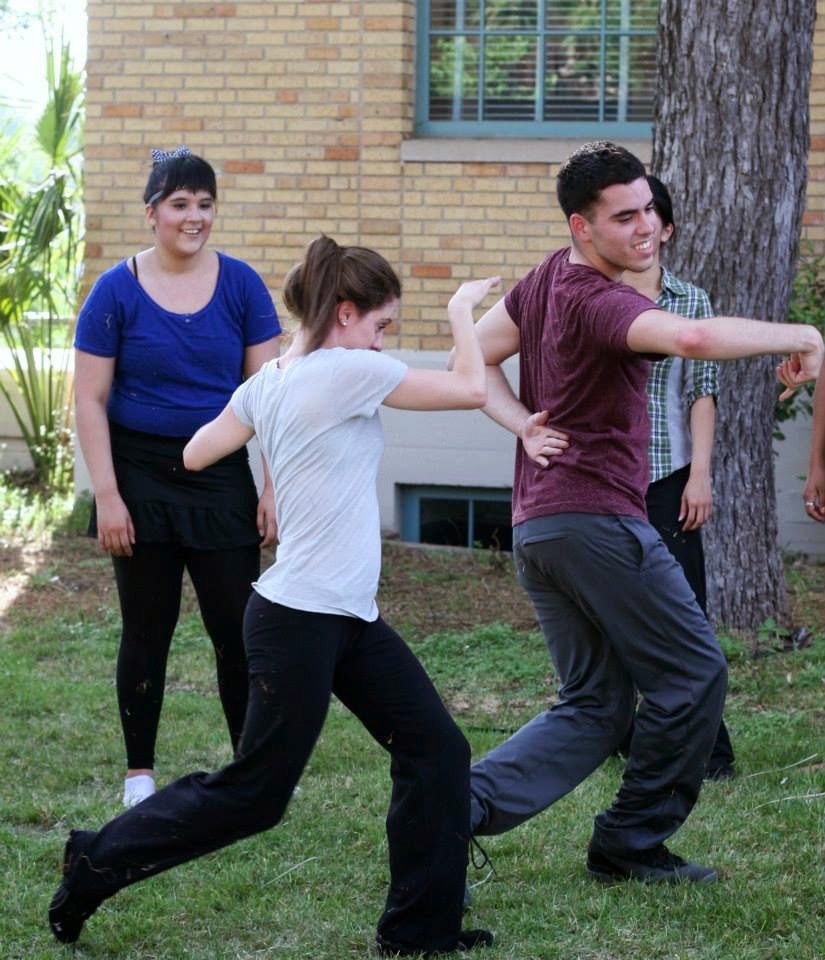Last week our wonderful dance professor Darla Johnson was
enjoying watching a seven week project come to powerful fruition at McCallum
High School Fine Arts Academy. Co-directed with Texas Tech dance faculty Nicole
Wesley and helped by student intern Sarah Wingfield, who also edited and
directed a new dance film at the high school for the show, The Justice Project
was an incredible examination of the personal stories of these high school
dancers and what justice meant to them.
 |
| Dancers against Nicole Wesley's film |
How did The JUSTICE Project start?
Darla Johnson: This
is actually the sixth manifestation of The JUSTICE Project. We started because
we wanted to bring the students together from ACC and Spelman
College. Nicole had danced in my
company (Johnson/Long Dance) and she was teaching in Georgia
at Spelman. I got funding from the VP’s office at ACC to take us down to Atlanta
for two weeks.
With the diversity of ACC and the traditional background of
Spelman being an all black woman’s school, the project had a lot of themes
surrounding racism and justice. Those themes have been a central part of the project since.
 |
| McCallum dancers in The JUSTICE Project. |
The project is what the participants bring. We use the same
structure but it’s always different material. We’re crafting the same ideas but
the movement is unique to the dancers. The whole thing evolves from structure,
creation, and the exercises Nicole and I give the dancers.
One of the big themes that this JUSTICE Project explored was
community; being a group.
Sarah Wingfield: They talked a lot about what makes a leader
different; the differences between being a leader and a follower.
 |
| Lauren on the right. |
Lauren Lym, a Junior at McCallum, and Cohen Lewis-Hill, a
Senior and dual-enrolled student with us at ACC, had a great experience
throughout the collaborative process.
What was it like to be a part of something like this?
Lauren Lym: It was crazy! What Darla has done is incredible
and breaks my hear that I’m going to lose all the seniors after we’ve grown so
close. The experience of sharing stories, creating together; we learned how to
really all dance together. The whole process was beyond fun – it was really
special, we all became like sisters. We all started out in these little
cliques, some people I had never had the courage to say hi too I was too shy,
but now we’re all together in this. I’ve never felt so connected to my class.
Cohen Lewis-Hill: It was intense. The project is a lot more involved than most high school projects we’ve done before. It demands a true emotional and mental commitment. We do a lot of emotional and intellectual performances at McCallum but this brought it to a new level.
 |
| Cohen |
What was the biggest challenge of the project?
Cohen Lewis-Hill: Opening up and telling our stories was the
most challenging, but the most rewarding too. Being that vulnerable is hard,
but it made [the piece] what it was.
What was the video process like?
Sarah Wingfield: Miss Adamez had seen the video I made in
Jose Bustamante’s Dance Film class at ACC, so she asked me to make one with the students
here. I played with a lot of different materials because I wanted to show the
students that dance isn’t just what you do onstage – movement is in what you
do. I wanted the students to experience what movement could be. Experimenting
with light showed how movement flows in a different way and helps you
appreciate small things as something whole. The paint was to see the final
product of movement initiated from the body. The cornstarch section was to give
the students another way to connect to how their bodies can manipulate another
medium, and how that medium moves on its own. What quality can you add when
you’re influencing that movement?
I put the video together as a kind of documentation of what
that process was; a
look what we did organized in a visually aesthetic way.
 |
A still from Sarah's film
|
Pictures by Anne Wharton










































